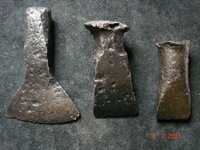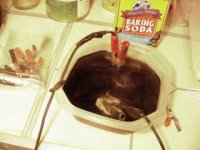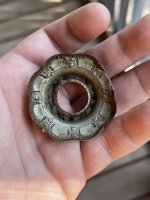Don in SJ
Silver Member
- May 20, 2005
- 4,931
- 832
- Detector(s) used
- MINELAB SE Pro
- Primary Interest:
- All Treasure Hunting
After reading Badger's and others postings on cleaning iron, I decided to give it a whirl. My first attempt at doing iron and found it to be quite different than doing a beach found Mercury dime. 
After a bit of trial an error, I finally settled on the following procedure and equipment setup.
I liked the Folger Coffee can idea, but for my Iron Trivet the can was way too small to consider.
I wanted something that would not tip over, something that can hold an artifact that is up to 12-14 inches long and have ease of cleaning.
So, I went to the local Dollar store and bought a plastic rectangle shaped flower box.
A couple of questions I had, which I really did not see a direct answers for on the forum were, "does the Anode have to be close to equal in size to the item being cleaned?" And the second question was "does the electrolyte solution have to be changed during the process a lot or not at all?"
I came to the conclusion that the anode should be close to equal in size and that a sterling silver spoon is not quite as a good of an anode as what I eventually ended up using.
Also, after changing the electrolite solution several times and going through a bit of baking soda I finally decided to try to reuse the dirty stuff and yes, it was just as good, so the answer to the second question on changing the electrolite out was, no do not, it seems to work for a long time, seems like the dirtier it got the better.
Here was my setup for doing a medium sized Iron artifact
1 Cell Phone Charger - 9 Volts 265ma
2 Alligator Clips
1 Plastic Flower Rectangular Box 14"L x 6"W x 6" deep
1 Box of Baking Soda - Added enough till water felt slippery
1 Brass Brush - toothbrush style
1 Anode - I used a worn out Circular Saw Blade
When I first tried it, the action was slow, then I read where you should file down to bare metal at a inconspious area for better contact, once I did that it worked much faster.
I think the time to complete depends upon the object and how much rust is caked on, plus the strength of the milliamperes of your power supply. My first iron took almost 3 full days of cooking, but the second iron, which is bigger got done in a little over a day.
The rinse baths, which I used distilled water, went thru using both hot rinses followed by cold rinses, for about a day. I finished with a hot rinse, then removed the trivet and put under a hot lamp for a several hours to dry thoroughly.
While it was drying I experimented on two ways of preserving the trivet, since I had no microcystallaine wax to use it left me with three choices, no treatment at all, just a good thorough drying; or, spray the trivet with Acrylic Lacquer, Matte finish; or do what my wife suggested and that was to treat the trivet like you do with a brand new Cast Iron Pan.
I dismissed the idea of no treatment at all, due to all the nooks and crannies on the trivet, felt that it did need some type of protection. So, that left me with trying the pan and the baking method.
I took two other iron artifacts and treated one with the spray lacquer and the other I coated with Crisco Oil and baked in a portable over (outside) at 500 degrees for one hour.
After examining my two samples, they both looked similar in looks and feel. But, I noticed that the spray would be heavier and shinier where it would collect in low areas and that the oil was much more even in appearance. So, I decided to go ahead and "bake with oil" my trivet.
In a few more days, I will post a photo of both trivets and both irons and my experience with electrolysis on iron artifacts will be done for awhile, but is has been a nice new and exciting experience and another aspect of our hobby.
Thanks to Badger, Mirage, and Conservator and others for all the previous posts which have helped.
Don in South Jersey

After a bit of trial an error, I finally settled on the following procedure and equipment setup.
I liked the Folger Coffee can idea, but for my Iron Trivet the can was way too small to consider.
I wanted something that would not tip over, something that can hold an artifact that is up to 12-14 inches long and have ease of cleaning.
So, I went to the local Dollar store and bought a plastic rectangle shaped flower box.
A couple of questions I had, which I really did not see a direct answers for on the forum were, "does the Anode have to be close to equal in size to the item being cleaned?" And the second question was "does the electrolyte solution have to be changed during the process a lot or not at all?"
I came to the conclusion that the anode should be close to equal in size and that a sterling silver spoon is not quite as a good of an anode as what I eventually ended up using.
Also, after changing the electrolite solution several times and going through a bit of baking soda I finally decided to try to reuse the dirty stuff and yes, it was just as good, so the answer to the second question on changing the electrolite out was, no do not, it seems to work for a long time, seems like the dirtier it got the better.

Here was my setup for doing a medium sized Iron artifact
1 Cell Phone Charger - 9 Volts 265ma
2 Alligator Clips
1 Plastic Flower Rectangular Box 14"L x 6"W x 6" deep
1 Box of Baking Soda - Added enough till water felt slippery
1 Brass Brush - toothbrush style
1 Anode - I used a worn out Circular Saw Blade

When I first tried it, the action was slow, then I read where you should file down to bare metal at a inconspious area for better contact, once I did that it worked much faster.
I think the time to complete depends upon the object and how much rust is caked on, plus the strength of the milliamperes of your power supply. My first iron took almost 3 full days of cooking, but the second iron, which is bigger got done in a little over a day.
The rinse baths, which I used distilled water, went thru using both hot rinses followed by cold rinses, for about a day. I finished with a hot rinse, then removed the trivet and put under a hot lamp for a several hours to dry thoroughly.
While it was drying I experimented on two ways of preserving the trivet, since I had no microcystallaine wax to use it left me with three choices, no treatment at all, just a good thorough drying; or, spray the trivet with Acrylic Lacquer, Matte finish; or do what my wife suggested and that was to treat the trivet like you do with a brand new Cast Iron Pan.
I dismissed the idea of no treatment at all, due to all the nooks and crannies on the trivet, felt that it did need some type of protection. So, that left me with trying the pan and the baking method.
I took two other iron artifacts and treated one with the spray lacquer and the other I coated with Crisco Oil and baked in a portable over (outside) at 500 degrees for one hour.
After examining my two samples, they both looked similar in looks and feel. But, I noticed that the spray would be heavier and shinier where it would collect in low areas and that the oil was much more even in appearance. So, I decided to go ahead and "bake with oil" my trivet.
In a few more days, I will post a photo of both trivets and both irons and my experience with electrolysis on iron artifacts will be done for awhile, but is has been a nice new and exciting experience and another aspect of our hobby.
Thanks to Badger, Mirage, and Conservator and others for all the previous posts which have helped.
Don in South Jersey


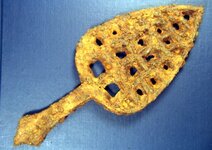
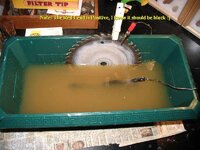
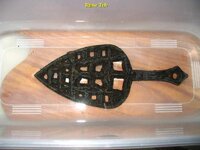
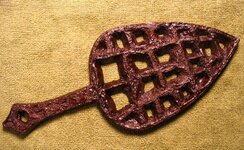
 I only use it on the good stuff. Looks like your artifact cleaned up really nice!
I only use it on the good stuff. Looks like your artifact cleaned up really nice!